First light 2020 | Website www.skatelescope.org | |
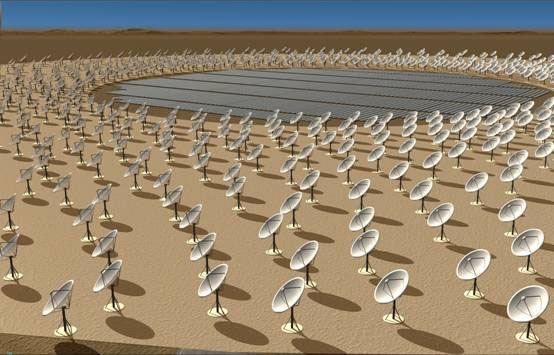 | ||
Built Phase 1 2018-2023Phase 2 2023-2030 Collecting area 1 km (11,000,000 sq ft) | ||
Square kilometre array
The Square Kilometre Array (SKA) is a large multi radio telescope project aimed to be built in Australia and South Africa. If built, it would have a total collecting area of approximately one square kilometre. It would operate over a wide range of frequencies and its size would make it 50 times more sensitive than any other radio instrument. It would require very high performance central computing engines and long-haul links with a capacity greater than the current global Internet traffic. It should be able to survey the sky more than ten thousand times faster than ever before.
Contents
- Square kilometre array
- Why south africa is building the square kilometre array adrian tiplady tedxjohannesburg
- Organisation
- Description
- Key projects
- Extreme tests of general relativity
- Galaxies cosmology dark matter and dark energy
- Epoch of re ionization
- Cosmic magnetism
- Search for extraterrestrial life
- Locations
- Precursors pathfinders and design studies
- Australian SKA Pathfinder ASKAP
- MeerKAT
- Murchison Widefield Array MWA
- Pathfinders
- Allen Telescope Array
- LOFAR
- Design studies
- Data challenges
- Technology Development Project TDP
- Timeline and funding
- Project risks
- Opposition to the SKA project
- References
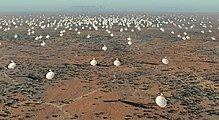
With receiving stations extending out to distance of at least 3,000 kilometres (1,900 mi) from a concentrated central core, it would exploit radio astronomy's ability to provide the highest resolution images in all astronomy. The SKA would be built in the southern hemisphere, in sub-Saharan states with cores in South Africa and Australia, where the view of the Milky Way Galaxy is best and radio interference least.
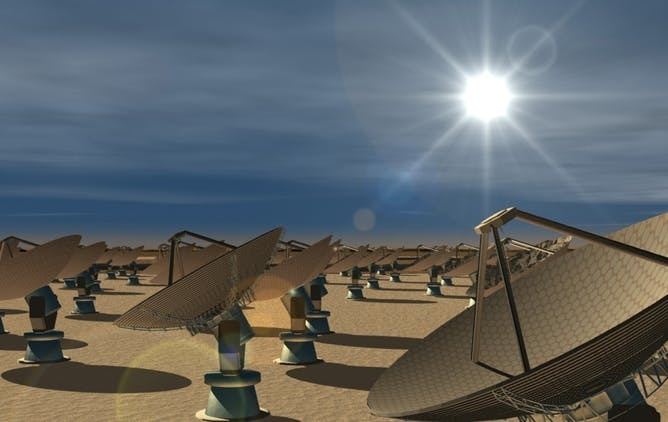
Construction of the SKA is scheduled to begin in 2018 for initial observations by 2020, but the construction budget is not secured at this stage. The SKA would be built in two phases, with Phase 1 (2018-2023) representing about 10% of the capability of the whole telescope. Phase 1 of the SKA was cost-capped at 650 million euros in 2013, while Phase 2's cost has not yet been established. The headquarters of the project are located at the Jodrell Bank Observatory, in the UK.
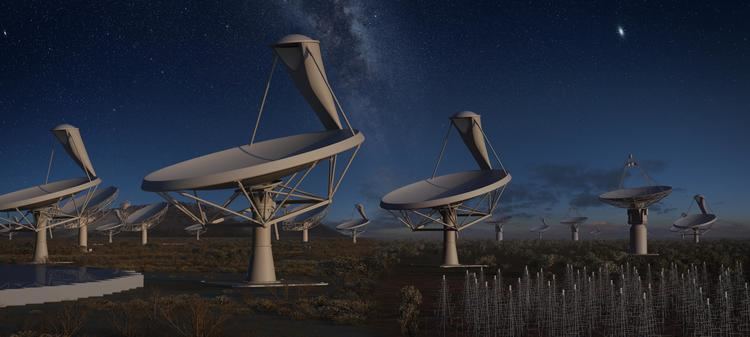
Why south africa is building the square kilometre array adrian tiplady tedxjohannesburg
Organisation
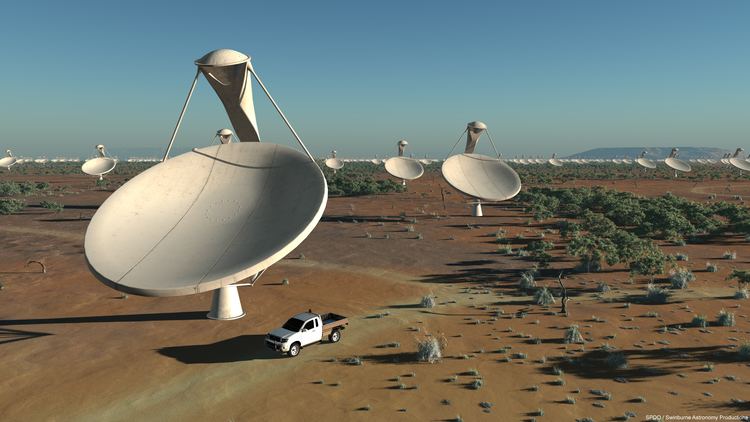
The SKA—a global project with twelve member countries—aims to answer fundamental questions about the origin and evolution of the Universe. In the early days of planning, China vied to host the SKA, proposing to build several large dishes in the natural limestone depressions (karst) that dimple its southwestern provinces; China called their proposal Kilometer-square Area Radio Synthesis Telescope (KARST). In April 2011, Jodrell Bank Observatory of the University of Manchester, in Cheshire, England was announced as the location for the project headquarters.
In November 2011, the SKA Organisation was formed and the project moved from a collaboration to an independent, not for profit, company. As of August 2014, the members of the SKA Organisation are:
Description
The SKA will combine the signals received from thousands of small antennas spread over a distance of several thousand kilometres to simulate a single giant radio telescope capable of extremely high sensitivity and angular resolution, using a technique called aperture synthesis. Some of the sub-arrays of the SKA will also have a very large field-of-view (FOV), making it possible to survey very large areas of sky at once. One innovative development is the use of focal-plane arrays using phased-array technology to provide multiple FOVs. This will greatly increase the survey speed of the SKA and enable several users to observe different pieces of the sky simultaneously, which is useful for (e.g.) monitoring multiple pulsars. The combination of a very large FOV with high sensitivity means that the SKA will be able to compile extremely large surveys of the sky considerably faster than any other telescope.
The SKA will provide continuous frequency coverage from 50 MHz to 14 GHz in the first two phases of its construction. A third phase will then extend the frequency range up to 30 GHz.
The frequency range from 50 MHz to 14 GHz, spanning more than two decades, cannot be realised using one design of antenna and so the SKA will comprise separate sub-arrays of different types of antenna elements that will make up the SKA-low, SKA-mid and survey arrays:
- SKA-low array – a phased array of simple dipole antennas to cover the frequency range from 50 to 350 MHz. These will be grouped in 100 m diameter stations each containing about 90 elements.
- SKA-mid array – an array of several thousand dish antennas (around 200 to be built in Phase 1) to cover the frequency range 350 MHz to 14 GHz. It is expected that the antenna design will follow that of the Allen Telescope Array using an offset Gregorian design having a height of 15 metres and a width of 12 metres.
- SKA-survey array – a compact array of parabolic dishes of 12–15 meters diameter each for the medium-frequency range, each equipped with a multi-beam, phased array feed with a large field of view and several receiving systems covering about 350 MHz – 4 GHz. The survey sub-array was removed from the SKA1 specification following a "rebaselining" exercise in 2015.
The area covered by the SKA – extending out to ~3000 km – will comprise three regions:
- A central region containing about 5 km diameter cores of SKA-mid antennas (South Africa) and SKA-low dipoles (Western Australia). These central regions will contain approximately half of the total collecting area of the SKA arrays.
- A mid region extending out to 180 km. This will contain dishes and pairs of SKA-mid and SKA-low stations. In each case they will be randomly placed within the area with the density of dishes and stations falling off towards the outer part of the region.
- An outer region from 180 km to 3000 km. This will comprise five spiral arms, along which dishes of SKA-mid, grouped into stations of 20 dishes, will be located. The separation of the stations increases towards the outer ends of the spiral arms.
Key projects
The capabilities of the SKA will be designed to address a wide range of questions in astrophysics, fundamental physics, cosmology and particle astrophysics as well as extending the range of the observable universe. A number of key science projects that have been selected for implementation via the SKA are listed below.
Extreme tests of general relativity
For almost one hundred years, Einstein's general theory of relativity has precisely predicted the outcome of every experiment made to test it. Most of these tests, including the most stringent ones, have been carried out using radio astronomical measurements. By using pulsars as cosmic gravitational wave detectors, or timing pulsars found orbiting black holes, astronomers will be able to examine the limits of general relativity such as the behaviour of spacetime in regions of extremely curved space. The goal is to reveal whether Einstein was correct in his description of space, time and gravity, or whether alternatives to general relativity are needed to account for these phenomena.
Galaxies, cosmology, dark matter and dark energy
The sensitivity of the SKA in the 21 cm hydrogen line will map a billion galaxies out to the edge of the observable Universe. The large-scale structure of the cosmos revealed will give constraints to determine the processes resulting in galaxy formation and evolution. Imaging hydrogen through the Universe will provide a three-dimensional picture of the first ripples of structure that formed individual galaxies and clusters. This may also allow the measurement of effects hypothetically caused by dark energy and causing the increasing rate of expansion of the universe.
The cosmological measurements enabled by SKA galaxy surveys include testing models of dark energy, gravity, the primordial universe, fundamental cosmology tests, and they are summarized in a series of papers available online.
Epoch of re-ionization
The SKA is intended to provide observational data from the so-called Dark Ages (between 300,000 years after the Big Bang when the radiation stops and the universe cools) and the time of First Light (a billion years later when young galaxies are seen to form for the first time). By observing the primordial distribution of gas, the SKA should be able to see how the Universe gradually lit up as its stars and galaxies formed and then evolved. This period between the Dark Ages and First Light is considered the first chapter in the cosmic story of creation and the distance to see this event is the reason for the Square Kilometre Array's design. To see back to First Light requires a telescope 100 times more powerful than the biggest radio telescopes currently in the world, taking up 1 million square metres of collecting area, or one square kilometre.
Cosmic magnetism
It is still not possible to answer basic questions about the origin and evolution of cosmic magnetic fields, but it is clear that they are an important component of interstellar and intergalactic space. By mapping the effects of magnetism on the radiation from very distant galaxies, the SKA will investigate the form of cosmic magnetism and the role it has played in the evolving Universe.
Search for extraterrestrial life
This key science program, called "Cradle of Life", will focus on three objectives: protoplanetary discs in habitable zones, search for prebiotic chemistry, and the search for extraterrestrial intelligence (SETI).
Locations
The headquarters of the SKA will be located at Manchester's Jodrell Bank Observatory, Cheshire, England.
Suitable sites for the SKA telescope must be in unpopulated areas with guaranteed very low levels of man-made radio interference. Four sites were initially proposed in South Africa, Australia, Argentina and China. After considerable site evaluation surveys, Argentina and China were dropped and the other two sites were shortlisted (with New Zealand joining the Australian bid, and 8 other African countries joining the South African bid):
Australia and New Zealand: The core site is located at the Murchison Radio-astronomy Observatory (MRO) at Mileura Station near Boolardy in Western Australia 315 km north-east of Geraldton on a flat desert-like plain at an elevation of about 460 metres. The most distant stations will be located in New Zealand.
South Africa: The core site is located at 30°43′16.068″S 21°24′40.06″E at an elevation of about 1000 metres in the Karoo area of the arid Northern Cape Province, about 75 km north-west of Carnarvon, with distant stations in Botswana, Ghana, Kenya, Madagascar, Mauritius, Mozambique, Namibia and Zambia.
On 10 March 2012 it was reported that the SKA Site Advisory Committee had made a confidential report in February that the South African bid was stronger. The final decision on the site by the project's board of directors was expected on 4 April 2012. However a scientific working group was set up to explore possible implementation options of the two candidate host regions, and its report was expected in mid May 2012.
On 25 May 2012 it was announced that the SKA will be split over the South African and African sites and the Australia and New Zealand sites. While New Zealand remains a member of the SKA Organisation, as of 2014 it appears that no SKA infrastructure is likely to be in New Zealand.
Precursors, pathfinders and design studies
Many groups are working globally to develop the technology and techniques required for the SKA. Their contributions to the international SKA project are classified as either: Precursors, Pathfinders or Design Studies.
Australian SKA Pathfinder (ASKAP)
The Australian SKA Pathfinder, or ASKAP, is an A$100 million project to build a telescope array of thirty-six twelve-metre dishes. It will employ advanced, innovative technologies such as phased array feeds to give a wide field of view (30 square degrees).
ASKAP is being built by CSIRO at the Murchison Radio-astronomy Observatory site, located near Boolardy in the mid-west region of Western Australia. All 36 antennas and their technical systems were officially opened in October 2012.
MeerKAT
MeerKAT is a South African project to build an array of sixty-four 13.5-metre diameter dishes as a world class science instrument, and also to help develop technology for the SKA. KAT-7, a seven-dish engineering and science testbed instrument for MeerKAT, near Carnarvon in the Northern Cape Province of South Africa is already up and running. As of July 2016, only sixteen 13.5-metre diameter (44.3 feet) dish antennae have been completed and are functioning, and the remainder are planned to be in service by 2017. The dishes will be equipped with a number of high performance single pixel feeds to cover frequencies from 580 MHz up to 14 GHz.
Murchison Widefield Array (MWA)
The Murchison Widefield Array is a low-frequency radio array operating in the frequency range 80–300 MHz also under construction at the Murchison Radio-astronomy Observatory site in Western Australia.
Pathfinders
Allen Telescope Array
The Allen Telescope Array uses innovative 6.1m offset Gregorian dishes equipped with wide band single feeds covering frequencies from 500 MHz to 11 GHz. The 42-element array now in operation is to be extended to 350 elements. The dish design has explored methods of low-cost manufacture.
LOFAR
LOFAR—a €150 million Dutch-led project—is building a novel low frequency phased aperture arrays spread over northern Europe. An all-electronic telescope covering low frequencies from 10 to 240 MHz, it came online from 2009 to 2011. LOFAR is currently developing crucial processing techniques vital to the SKA.
Design studies
Data challenges
The amount of sensory information collected pose a huge storage problem and require real-time signal processing to reduce the information to relevant data. In mid 2011 it was estimated the array could generate an exabyte a day of raw data, which could be compressed to around 10 petabytes.
Technology Development Project (TDP)
The Technology Development Project, or TDP, is a US$12 million project to specifically develop dish and feed technology for the SKA. It is operated by a consortium of universities led by Cornell University and was completed in 2012.
Timeline and funding
The SKA was originally conceived in 1991 with an international working group set up in 1993. This led to the signing of the first Memorandum of Agreement in 2000. Considerable early development work then followed. This culminated in the commencement of PrepSKA in 2008 leading to a full SKA design in 2012. Construction of Phase 1 will take place from 2018 to 2020 providing an operational array capable of carrying out the first science. Phase 2 will then follow for completion in 2025 providing full sensitivity for frequencies up to at least 14 GHz.
The SKA is projected to cost €2 billion, this includes €650 million for Phase 1 completing 2020. The funding will come from many international funding agencies. The SKA and the European Extremely Large Telescope (E-ELT) are the two flagship facilities for ground-based astronomy in the future. They were formally equal high priority projects in the ASTRONET roadmap for European astronomy, but the E-ELT is now mostly funded.
Project risks
Potential risks for priority astronomical sites in South Africa are protected by the Astronomy Geographic Advantage Act of 2007. Put in place to specifically support the South African SKA bid, it outlaws all activities that could endanger scientific operation of core astronomical instruments. In 2010, concerns were raised over the will to enforce this law when Royal Dutch Shell applied to explore the Karoo for shale gas using hydraulic fracturing, an activity that would have the potential to increase radio interference at the site.
An identified remote station location for the southern African array in Mozambique was subject to flooding and excluded from the project, despite the SKA Site Selection Committee technical analysis reporting that all African remote stations could implement flood mitigation solutions.
Australia's first radio quiet zone was established by the Australian Communications and Media Authority (ACMA) on 11 April 2005 specifically to protect and maintain the current "radio-quietness" of the main Australian SKA site at the Murchison Radio-astronomy Observatory.
In February 2012, a former Australian SKA Committee chairman raised concerns with South African media about risks at the Australian candidate site, particularly in terms of cost, mining interference and land agreements. SKA Australia stated that all points had been addressed in the site bid.
During 2014, South Africa experienced a month-long strike action by the National Union of Metalworkers (NUMSA), which added to the delays of the installation of dishes. The plan was to have six dishes operational by November, but only one MeerKAT dish stands on the Karoo site in the Northern Cape.
The largest risk to the overall project is probably its budget, which up until now has not been committed.
Opposition to the SKA project
There has been opposition to the project from farmers and businesses, as well as individuals, since the project's inception. The advocacy group called Save the Karoo has stated that the radio quiet zone will create further unemployment in the region where unemployment is already above 32%. Farmers had stated that the agriculture-based economy in the Karoo would collapse if they were forced to sell their land, with land expropriation also on the table. Most fear that a Zimbabwe-style land expropriation will have negative effects on the country as a whole.
